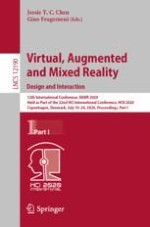The 2 volume-set of LNCS 12190 and 12191 constitutes the refereed proceedings of the 12th International Conference on Virtual, Augmented and Mixed Reality, VAMR 2020, which was due to be held in July 2020 as part of HCI International 2020 in Copenhagen, Denmark. The conference was held virtually due to the COVID-19 pandemic.
A total of 1439 papers and 238 posters have been accepted for publication in the HCII 2020 proceedings from a total of 6326 submissions.
The 71 papers included in these HCI 2020 proceedings were organized in topical sections as follows:
Part I: design and user experience in VAMR; gestures and haptic interaction in VAMR; cognitive, psychological and health aspects in VAMR; robots in VAMR.
Part II: VAMR for training, guidance and assistance in industry and business; learning, narrative, storytelling and cultural applications of VAMR; VAMR for health, well-being and medicine.
